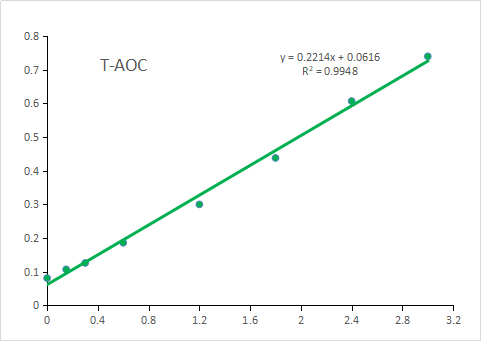| Product name | CheKine™ Micro Total Antioxidant Capacity (TAC) Assay Kit |
| Applications notes | CheKine™ Micro Total Antioxidant Capacity (TAC) Assay Kit provides a simple and easy colorimetric assay for measuring Total Antioxidant Capacity in serum, plasma, cell culture supernatants, urine, tissue/ cell lysates and other biological fluids. In this assay, Fe3+-TPTZ is reduced by antioxidant to Fe2+-TPTZ. The enzyme catalyzed reaction products Fe2+-TPTZ can be measured at a colorimetric readout at 593 nm. |
| Kit components | • Assay Buffer (10X) • Substrate Diluent • Substrate • Reaction Buffer • ascorbic acid (positive control) |
| Features & Benefits | • Determination of Total Antioxidant Capacity in serum, plasma, cell/tissue samples, urine and bacteria samples. • Using a stronger antioxidant, sascorbic acid as positive control, instead of the frequently-used Trolox. • The reaction is carried out under acidic conditions, which can inhibit some endogenous interference factors. |
| Usage notes | • It is recommended to perform several dilutions of your sample to ensure the readings are within the standard value range. • Fresh samples are necessary for good results. If not assayed immediately, samples can be stored at -80°C for one month. • Can not use EDTA as the anticoagulant for serum and plasma samples. The samples also can not contain DTT, Mercaptoethanol, Tween, Triton, NP-40. |
| Storage instructions | Storage at -20°C and Keep from light immediately upon receipt. Kit has a storage time of 12 months from receipt. Refer to list of materials supplied for storage conditions of individual components. |
| Shipping | Gel pack with blue ice. |
| Precautions | The product listed herein is for research use only and is not intended for use in human or clinical diagnosis. Suggested applications of our products are not recommendations to use our products in violation of any patent or as a license. We cannot be responsible for patent infringements or other violations that may occur with the use of this product. |
| Background | Antioxidants play an important role in preventing the formation and scavenging of free radicals and other potentially toxic oxidizing species. There are three categories of antioxidant species: enzyme systems (GSH reductase, catalase, peroxidase, etc.), small molecules (ascorbate, uric acid, GSH, vitamin E, etc.) and proteins (albumin, transferrin, etc.) |

Fig. Standard Curve of Total Antioxidant Capacity (TAC) Assay. The y-axis is OD593 and the x-axis is Fe2+ concentration (mM).
Author:Wang, Jiayi, et al. Publication name: Environmental Science & Technology IF:11.300
Author: Lin S, Zhang Q, Li S Publication name:CELL PROLIFERATION IF:8.755
Author:Jia, Lina, et al. Publication name:Ecotoxicology and Environmental Safety IF:6.8
Author:Jiang, Danni, et al Publication name:Ecotoxicology and Environmental Safety IF:6.8
Author:Wang, Ying, et al Publication name:Ecotoxicology and Environmental Safety IF:6.8
Author:Jiang D, Xu Y, Han X Publication name:Ecotoxicology and Environmental Safety IF:6.80
Author:Jiang, Danni, et al. Publication name:Ecotoxicology and environmental safety IF:6.2
Author:Wang, Ying, et al. Publication name:Ecotoxicology and Environmental Safety IF:6.2
Author:Chen, Xiaoling, et al. Publication name: International Journal of Molecular Sciences IF:4.9
Author:Ma, Aijie, et al. Publication name: Frontiers in Plant Science IF:4.800
Author:Fu, Yang, et al. Publication name: Cartilage IF:2.700
Author:Wang, Chien-Hsing, Zih-Ting Huang, and Kuo-Feng Tai. Publication name: PloS one IF:2.600
Author: Nath D, Shivasekar M Publication name:Cureus Journal of Medical Science IF:1.315
You must be logged in to post a review.
Reviews
There are no reviews yet.